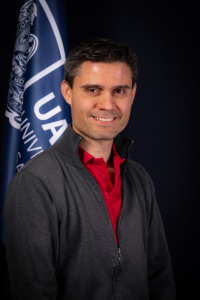Challenges for portable atomic gravimeters
Eduardo Gómez (UASLP)
ABSTRACT:
Atomic gravimetry provides a sensitive way to obtain absolute measurements of local gravity, something that has multiple applications in underground exploration and monitoring. Taking this sensors from the laboratory to practical applications requires overcoming several challenges. I will talk about our efforts to implement a portable gravimeter in the Gravico collaboration with an emphasis on the technological and fundamental challenges involved.
RECOMMENDED PAPERS:
- A good reference for a portable gravimeter is “Gravity measurements below 10^−9 g with a transportable absolute quantum gravimeter” Scientific ReportS | (2018) 8:12300 | DOI:10.1038/s41598-018-30608-1.
- A nice article about taking them out of the lab is “Taking atom interferometric quantum sensors from the laboratory to real- world applications” Nature reviews physics.
- In the direction of our contributions it is important to appreciate the simplicity introduced by the use of fiber modulators, and a good reference is “Multiple isotope magneto-optical trap from a single diode laser” J. Opt. Soc. Am. B Vol. 30, No. 5 / May 2013 / Pag. 1205.
- Also good to appreciate how a birefringent material would make the modulator more powerful, and a good reference is “Low phase noise beams for Raman transitions with a phase modulator and a highly birefringent crystal” Optics Express Vol. 25, No. 5 | 6 Mar 2017 | Pag. 5290.
BIO:
 He did his PhD in physics working in precision atomic spectroscopy using francium atoms with Dr. Luis Orozco at the University of Stony Brook. He continued with a postdoc working with excitations in sodium Bose Einstein Condensates with Dr. Paul Lett at the National Institute of Standards and Technology as part of the group of Dr. William Phillips.
He did his PhD in physics working in precision atomic spectroscopy using francium atoms with Dr. Luis Orozco at the University of Stony Brook. He continued with a postdoc working with excitations in sodium Bose Einstein Condensates with Dr. Paul Lett at the National Institute of Standards and Technology as part of the group of Dr. William Phillips.
He has been a faculty member at the Autonomous University of San Luis Potosi since 2007. He started the Cold Atoms lab that uses laser cooling techniques for precision measurements. In particular he works in converting the atoms into very sensitive devices that measure the gravitational acceleration.
He participates in an international collaboration, FrPNC, that uses francium atoms to study the weak force. He is currently leading a multi institutional collaboration, Gravico, devoted to the development of a portable gravimeter, that we hope will become the first commercial product based in Quantum Technologies made in Mexico. He contributed to the creation of the National Lab of Quantum Matter and his group became the Quantum Sensors Unit of that national laboratory. He served as president of the Quantum Information Division of the Mexican Physical Society until recently where he has leaded a Mexican Quantum Technology Initiative.
He has received the Cátedra Marcos Moshinsky, The Research award of the Academia Mexicana de Ciencias in the area of exact sciences and the Tadem award.
